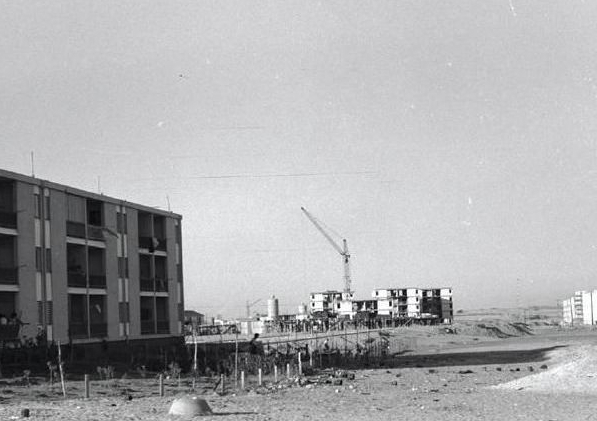There must be some consequence to how most of us grow up with dubious architecture. The “shikunim,” dour apartment blocks not quite as gargantuan as those of eastern Europe, but about equally ornate, make up a great deal of the urban and suburban Israeli landscape. They were mostly built during the 1950s and 60s to accommodate huge waves of Jewish newcomers from North Africa and elsewhere. They have grown to become the natural habitat of the Jewish Israeli blue-collar class and lower-middle class. As the years pass, they tend to deteriorate, exposing cheap materials and offhand design, becoming even uglier.
A childhood in golden Jerusalem offered no refuge. I was raised in a neighborhood made up entirely of such shikunim. They were all covered in Jerusalem-stone in accordance with the municipal ordinance made by the British in their day, and were somewhat more appealing than the concrete variety found on Israel’s coastal plane, but were dense and boxy all the same. Having moved with my parents to the States for a few years and experienced a house for the first time, I found myself writing short stories that evoked the experience of the shikunim.
In my stories, a strange traveling magician would come to entertain the children in the concrete courtyards. The mothers would look at him suspiciously from behind the clothes lines and the shabby fiberglass laundry-protectors. The magician brought to the ‘hood the magic of more romantic places, and at the same time emphasized the shikunim’s own mystique. I later found out that other artists have been likewise trapped by the lure of such places. Here’s a verse from Israeli poet Moshe Dor, written during the 1960s:
Go west, child of light
To the shikunim
Only a shadow goes over the water
Tall are the red squills
Salt climbs through the nostrils
And the sea holds your heels.
To me, this is a priceless image of a city like Ashdod, which at those times was still a treeless, dusty cluster of apartment blocks, situated directly on the seafront dunes, filled with children who were not quite Sabras, but were trying hard to be. The shikunim were a gift for those who waited long enough in the immigrant tent cities, a sign of coming up in the society. Unfortunately, for most of them this was the last rung of the ladder. Not all of them were poets who could actually benefit from the intensity of such town-scape.
The 25th of September marks the opening of the second Bienalle of Landscape Urbanism in Bat Yam. The previous such event was a major success. The city of Bat Yam, Israel’s densest shikunim wasteland, offered itself as a laboratory for ideas in urban design, development, landscaping and problem-solving. This was no dry academic seminar. Everything was tried on the ground, including the transformation of a shikun courtyard into a colorful paradise for the community.
The current bienalle is themed “Timing” in English, but its Hebrew title would be translated as “opportunity.” If this rings like Obama’s favorite word when meeting Netanyahu and Abbas, that’s no coincidence. Procceces of renewal start from within. Improving the looks and dynamics of our townscapes is inseperable from improving life in the region. The “broken window” theory works: fix the damaged bench on your street corner and you inspire dignity the entire neighborhood, which would lead to fewer damaged benches.
We can always always complain about the state of our deteriorating shikunim, we can write poems and stories about them, sweetening their austere effect, but actually participating in the adventure of Israeli urban renewal would truly reflect on other aspects of life here. Applying the ideas of the biennale and coming up with local initiatives would be priceless activism. So much of what we do here is deal with the flawed reality into which we were born. We’ve become skilled at it. If we can take on Beit Jalla’s concrete wall, we can take on those of Bat Yam.


